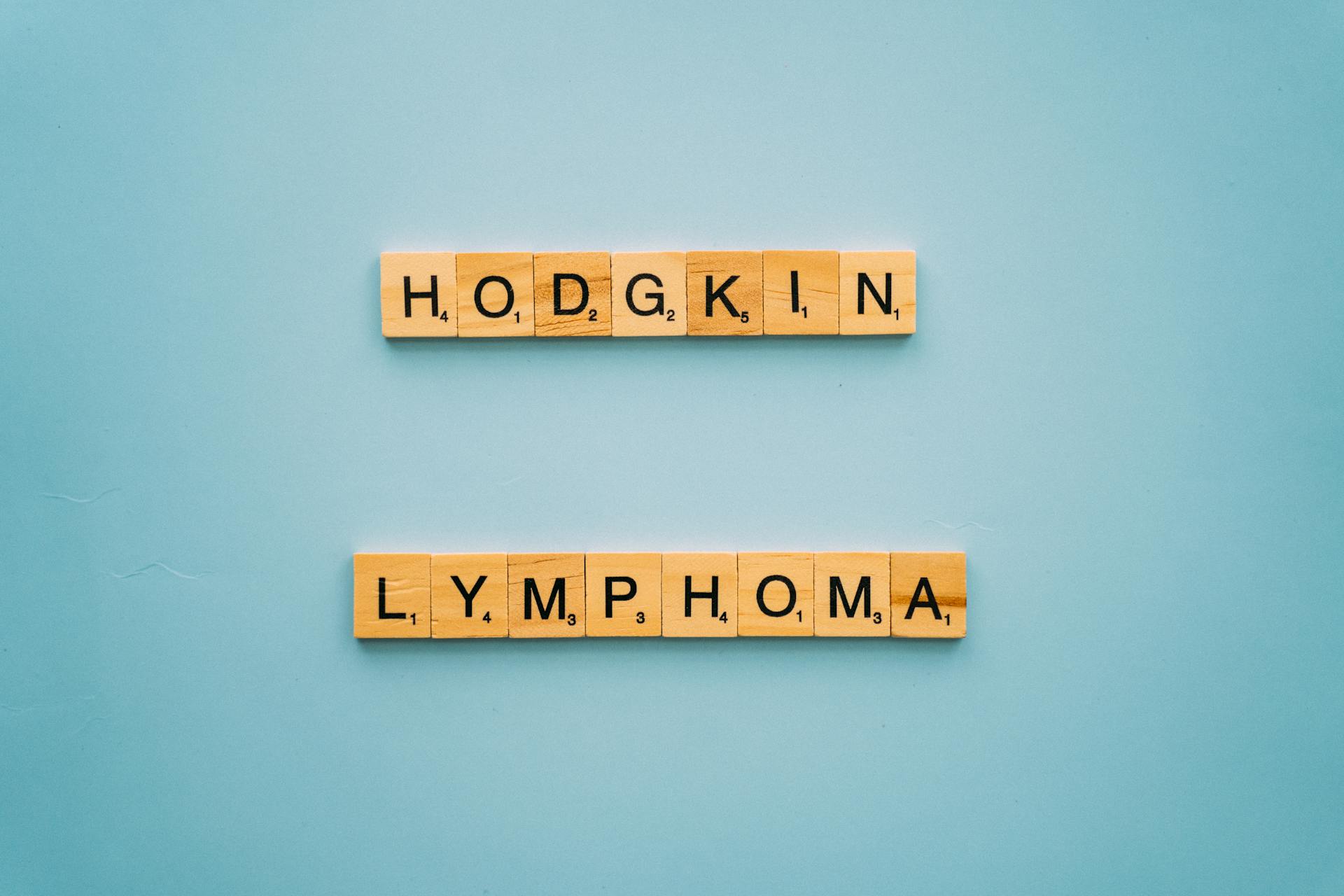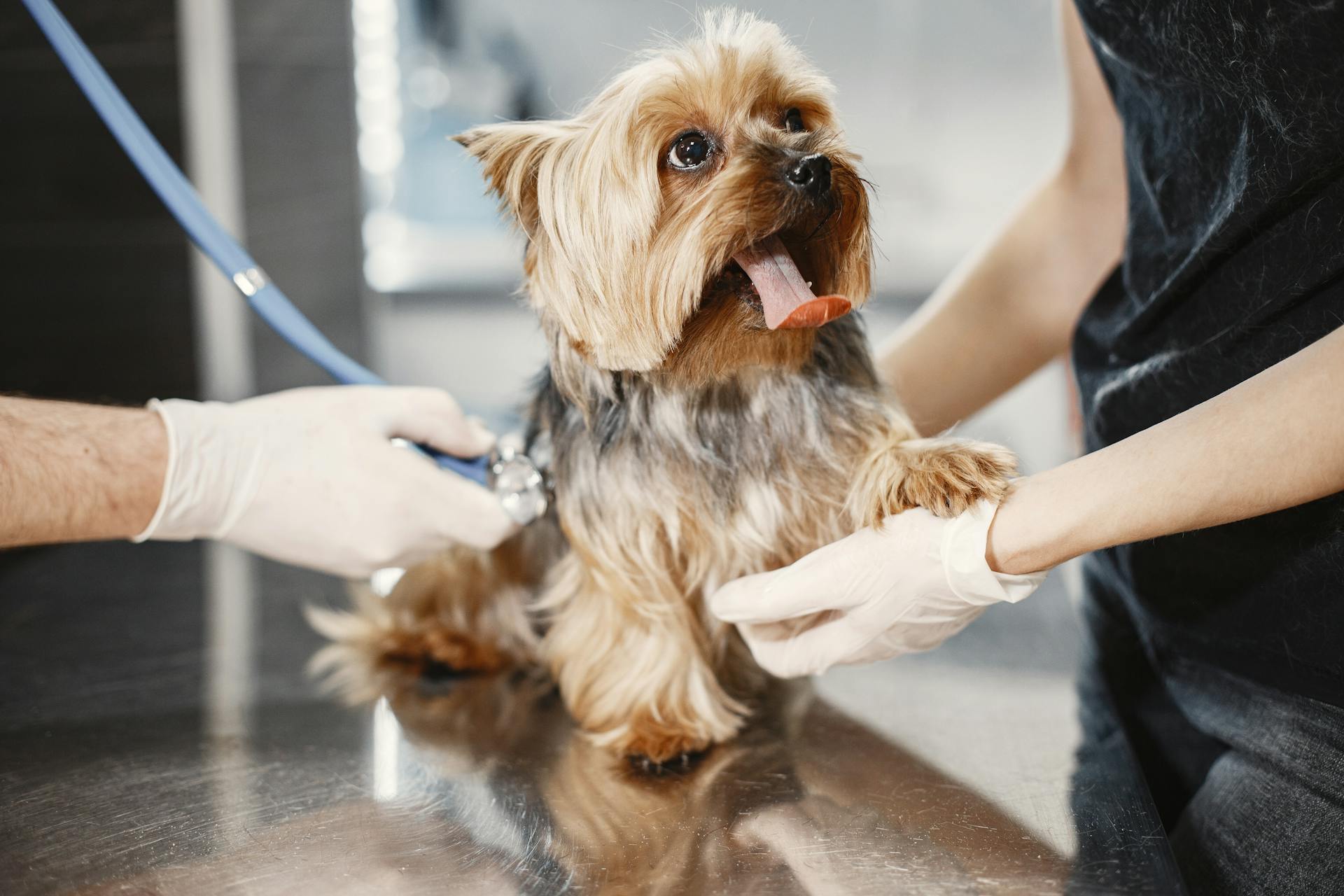
Indolent lymphoma in dogs is a type of cancer that affects the immune system, specifically the lymphatic system, which plays a crucial role in fighting off infections and diseases.
Indolent lymphoma is characterized by its slow growth and progression, which is why it's often referred to as "indolent." This means that it may not cause immediate symptoms, but it can still cause problems if left untreated.
The most common signs of indolent lymphoma in dogs include weight loss, lethargy, and loss of appetite. These symptoms can be vague and may resemble those of other conditions, making diagnosis challenging.
Indolent lymphoma can affect any age group of dogs, but it's more common in middle-aged to older dogs.
A different take: What Food Gives Dogs Diarrhea
What Is Indolent Lymphoma in Dogs?
Indolent lymphoma in dogs is a type of lymphoma that progresses slowly and may not cause symptoms for a long time. It's a low-grade lymphoma, which means it's not aggressive and doesn't spread quickly.
Indolent canine lymphoma makes up a portion of canine lymphoma cases, but the exact percentage isn't specified. It's worth noting that many other uncommon types and subtypes of canine lymphoma vary greatly based on cell types involved, location of symptoms, progression, and other factors.
If your dog has indolent lymphoma, your veterinarian or veterinary oncologist will be able to describe it in more detail, taking into account the specific characteristics of your dog's condition.
Causes and Risk Factors
Lymphoma in dogs is a complex disease with multiple potential causes.
The exact underlying causes of malignant lymphoma in dogs are still not fully understood, but research suggests it's likely a multifactorial issue involving infectious agents, environmental contamination, and immune dysfunction.
Some breeds, such as Boxers, Rottweilers, and Golden Retrievers, may be at a higher relative risk of developing lymphoma, but any breed can be affected.
Middle-aged to older dogs are more likely to develop lymphoma, with no significant association with sex.
Other B-Cell
Canine nodal marginal zone lymphoma is a type of indolent B-cell lymphoma that's generally more aggressive than others, with median progression-free intervals of just five months and overall survival times of 8.5 months.
This is less than splenic marginal zone lymphoma, which has a much better prognosis and can lead to long-term survival after splenectomy, with or without chemotherapy.
Mantle zone lymphoma and follicular lymphoma are rare in dogs, but they do appear to have a good prognosis with treatment.
Dogs with B-cell lymphoma typically respond better to chemotherapy and have longer remissions and survival times than dogs with T-cell lymphoma.
Readers also liked: T-cell Lymphoma in Dogs
Etiology
Lymphoma in dogs is a complex condition with multiple potential causes. The underlying causes of malignant lymphoma in dogs are still not fully understood and are likely to be multifactorial.
Infectious viruses or bacteria may play a role in the development of lymphoma in dogs. Some research suggests that exposure to certain environmental contaminants could also contribute to the risk of lymphoma.
Chromosomal abnormalities have been linked to the development of lymphoma in dogs. Strong magnetic fields and immune dysfunction are also potential contributing factors.
Lymphoma in dogs can be molecularly distinguished and categorized into discrete groups that correlate with biological aggressiveness.
Epidemiology
Lymphoma is the most common hematopoietic neoplasm in dogs, with a reported incidence approaching 0.1% of susceptible dogs.
Middle-aged to older dogs are typically affected by lymphoma, with no significant association with sex.
Some breeds, like Boxers, Rottweilers, and Golden Retrievers, may be at increased relative risk, but any breed can be affected.
Symptoms and Diagnosis
Symptoms of indolent lymphoma in dogs can be subtle and may not be immediately apparent. A physical exam can help identify swollen lymph nodes, which is a key indicator of the disease.
Generalized, nonpainful lymphadenopathy should raise suspicion for multicentric lymphoma, a type of indolent lymphoma. Fine-needle aspiration with cytologic evaluation is a highly effective method for identifying pathological monomorphic populations of lymphoid cells.
A fine needle aspirate (FNA) and cytology can be done during a vet visit and is a quick and easy test. This test involves inserting a tiny needle into an enlarged lymph node to draw out a sample of the inside, which can then be looked at under a microscope.
A biopsy may be necessary to confirm the diagnosis, especially if the cytology results are inconclusive. This involves surgically removing a piece of the enlarged lymph node and sending it to a lab for testing.
Splenic Marginal Zone
Splenic Marginal Zone lymphoma is associated with long-term survival after splenectomy, which is a surgical procedure to remove the spleen.
This type of lymphoma has a relatively good prognosis, especially when compared to other types of indolent B-cell lymphomas in dogs.
In fact, the overall survival times for Splenic Marginal Zone lymphoma can be quite impressive, especially when combined with chemotherapy.
However, it's worth noting that this type of lymphoma is relatively rare in dogs.
A fresh viewpoint: T Zone Lymphoma in Dogs
Lesions
Lesions in canine lymphoma can be quite telling, and I'd like to walk you through what to expect.
Lymph nodes affected by the disease are often 3–10 times their normal size and are nonpainful to the touch.
As the disease progresses, these lymph nodes can become fixed and compress surrounding tissues, leading to discomfort or functional issues.
The color of affected lymph nodes is usually gray to tan, and when cut open, they tend to bulge and lose their normal demarcation.

Hepatosplenomegaly, or enlargement of the liver and spleen, is also common, and can manifest as diffuse enlargement or multiple, pale nodules.
In the alimentary form of canine lymphoma, any part of the GI tract or mesenteric lymph nodes can be affected.
Other possible, though less common, sites of involvement include the bone marrow, CNS, kidney, heart, tonsils, pancreas, and eyes.
Diagnosis
Diagnosis is a crucial step in determining the type and severity of lymphoma in dogs. A physical exam is typically the first step, where your veterinarian will check all of your dog's lymph nodes and other vital signs.
If lymphoma is suspected, additional tests may be done, including bloodwork, which is often normal but can help understand your dog's general health. Mediastinal lymphoma can cause increased calcium levels, which would show up on bloodwork.
A fine needle aspirate (FNA) and cytology is a quick and easy test that involves inserting a tiny needle into an enlarged lymph node to draw out a sample of the inside. This material can be looked at under a microscope to identify pathological monomorphic populations of lymphoid cells.

A biopsy is a more expensive option, but it can provide more detailed information than cytology. It involves surgically removing a piece of an enlarged lymph node and sending it to a lab for testing.
Immunophenotyping is a specific laboratory test that determines if your dog's lymphoma is in the B- or T-cells. This information can provide good insight into prognosis and how well your dog may respond to treatment.
Here are the different diagnostic methods for lymphoma in dogs:
- Clinical evaluation (physical exam)
- Fine-needle aspiration with cytologic evaluation
- Tissue biopsy with histologic evaluation
- Molecular diagnostic techniques, including flow cytometry and PCR for antigen receptor rearrangement (PARR) assay
Dogs with B-cell lymphoma typically respond better to chemotherapy and have longer remissions and survival times than dogs with T-cell lymphoma.
Additional reading: Small Cell Lymphoma in Dogs
Discussion
As we've discussed the various symptoms and diagnosis methods, it's clear that early detection is crucial.
The symptoms of the condition can be quite non-specific, making it difficult to diagnose without a thorough medical examination.
Headaches, fatigue, and muscle pain are common symptoms that can be mistaken for other conditions.
Curious to learn more? Check out: Lymphoma Dogs Symptoms

In some cases, people may experience a sudden onset of symptoms, which can be a sign of a more serious underlying issue.
The diagnosis process typically involves a combination of physical examination, medical history, and laboratory tests.
A healthcare professional will likely ask a series of questions to gather more information about the symptoms and medical history.
Imaging tests, such as X-rays or MRIs, may also be ordered to rule out other possible causes of the symptoms.
In some cases, a biopsy may be necessary to confirm the diagnosis.
The good news is that with proper treatment, many people are able to manage their symptoms and lead active lives.
Treatment Options
Chemotherapy is the treatment of choice for lymphoma in dogs, and it's often the most effective way to manage the disease.
There are various chemotherapy protocols available, and the best one for your dog will depend on their specific case and your goals.
Your dog's oncologist is best positioned to determine which protocol to use, and they'll be able to tell you the latest updates on the most effective treatments.
Broaden your view: Best Food for Gassy Dogs
Some common first-line chemotherapy protocols include the CHOP protocol, which is considered the gold standard for canine lymphoma.
The CHOP protocol involves rotating through different medications, including cyclophosphamide, doxorubicin, vincristine, and prednisone, and it's usually administered once a week for 19 weeks.
With the CHOP protocol, 90% of dogs go into complete remission within the first few weeks, and remission usually lasts 4-6 months after completing treatment.
If your dog experiences a relapse, chemotherapy can be repeated, and most dogs will achieve a second remission with more treatment.
However, rescue protocols, such as the CHOP protocol, may not be effective forever, and your dog's oncologist may need to switch to a different protocol or combination of drugs.
It's also worth noting that some dogs may be candidates for a bone marrow transplant, which involves chemotherapy, radiation, and the infusion of healthy stem cells.
This procedure can be costly and is not a good fit for most dogs, but it has been shown to be effective in 30% of treated dogs.
In some cases, your dog's oncologist may recommend starting with a less aggressive treatment, such as prednisone, which can help slow the progression of the disease and improve your dog's quality of life.
However, it's essential to note that starting prednisone before introducing other chemotherapy drugs can make those drugs less effective.
Here are some key statistics on the effectiveness of different chemotherapy protocols:
Ultimately, the best treatment option for your dog will depend on their individual needs and circumstances, and your dog's oncologist will be able to help you make an informed decision.
Medications and Therapies
Chemotherapy is a common treatment for indolent lymphoma in dogs, often used in combination with other therapies.
The most commonly used chemotherapy agents for indolent lymphoma are chlorambucil, cyclophosphamide, and lomustine.
Lomustine has been shown to be effective in treating indolent lymphoma, with a median survival time of 12 months in one study.
Radiation therapy can also be used to treat indolent lymphoma, particularly in cases where the cancer is localized to a specific area.
The goal of radiation therapy is to deliver a high dose of radiation to the tumor while minimizing damage to surrounding healthy tissues.
Immunotherapy has also been explored as a treatment option for indolent lymphoma, with some studies showing promising results.
One study found that a combination of chemotherapy and immunotherapy resulted in a median survival time of 24 months for dogs with indolent lymphoma.
Surgery is not typically used to treat indolent lymphoma, as the cancer is often widespread and difficult to remove completely.
However, in some cases, surgery may be used to relieve symptoms or remove a tumor that is causing problems.
Prevention and Management
Reducing exposure to chemicals in your home can help decrease the risk of indolent lymphoma in your dog. You can start by reducing the use of pesticides around your home.
Some common household chemicals can also be hazardous to your dog's health. Reducing the use of chemical cleaning products within your home can help minimize exposure.
Paint fumes are another potential risk factor. Keep your dog out of the house when painting to prevent exposure.
Supplements
When considering supplements for your dog with lymphoma, it's essential to consult with your veterinarian first. They will help determine if a supplement is safe and won't interact with any medications or treatments.

There is no specific supplement that can treat lymphoma, but some might be helpful in general cancer cases. Always consult your veterinarian before adding a supplement.
Working with a veterinarian who knows about supplements and health can help you and your oncologist decide what to use and when. This can be especially important during chemotherapy, when side effects need to be carefully monitored.
Recommended read: What Can You Feed Dogs Instead of Dog Food
Prevention Strategies
Reducing your dog's exposure to certain chemicals can help decrease their risk of getting lymphoma.
Pesticides can be a major concern, so it's a good idea to reduce their use around your home. This will help minimize your dog's exposure to these chemicals.
Chemical cleaning products should also be used with caution. Try to find alternative, non-toxic cleaning solutions to keep your home clean and safe for your dog.
Painting can also be a source of chemical exposure for your dog. Keep them out of the house when painting to prevent them from inhaling paint fumes.
Here are some specific actions you can take to reduce your dog's exposure to chemicals:
- Reduce the use of pesticides around your home
- Reduce use of chemical cleaning products within your home
- Keep your dog out of the house when painting to prevent exposure to paint fumes
Clinical Staging and Tests
Clinical staging is a crucial step in diagnosing and treating indolent lymphoma in dogs. It helps determine the extent of the disease, which in turn guides treatment decisions.
The World Health Organization (WHO) staging scheme is commonly used to stage lymphoma in dogs, with five stages ranging from I to V. Stage I involves a single node or lymphoid tissue, while Stage V involves manifestation in the blood and bone marrow or other organ systems.
A veterinarian or veterinary oncologist may recommend various tests to help determine the stage and extent of the disease. These tests include bloodwork, urinalysis, chest radiographs (x-rays), ultrasound, and bone marrow biopsy or aspirate.
Here's a summary of the WHO Clinical Staging System for Lymphoma in Domestic Animals:
Staging Tests
Staging tests are crucial in determining the extent of lymphoma in your dog's body. Your veterinarian or veterinary oncologist may recommend a series of tests to help determine the stage of the disease.

Bloodwork is one of the tests used to stage lymphoma in dogs. This helps assess your dog's overall health and can indicate if lymphoma is present.
Urinalysis is another test that may be used to stage lymphoma. This test checks for any abnormalities in your dog's urine.
Chest radiographs, or x-rays, are also used to stage lymphoma in dogs. These images help identify any affected lymph nodes in your dog's chest area.
Ultrasound is a test that uses sound waves to create images of your dog's internal organs. This can help identify any affected lymph nodes or other abnormalities.
A bone marrow biopsy or aspirate may be necessary to determine the stage of lymphoma in your dog. This test involves taking a sample of your dog's bone marrow to check for any cancer cells.
The WHO Clinical Staging System for Lymphoma in Domestic Animals is a commonly used system to stage lymphoma in dogs. It classifies the disease into five stages, based on the extent of involvement in the body.
Here is a summary of the WHO Clinical Staging System:
Materials and Methods
We used a combination of clinical staging and various diagnostic tests to assess the severity of the condition.
The clinical staging involved a thorough physical examination, including a review of the patient's medical history and a series of standardized questions to determine the extent of the symptoms.
A blood test was also conducted to check for the presence of certain biomarkers associated with the condition.
The diagnostic tests included a chest X-ray, an electrocardiogram (ECG), and a computed tomography (CT) scan to evaluate the patient's lung function and rule out any underlying cardiac issues.
A biopsy was performed to collect tissue samples for further analysis, which helped confirm the diagnosis.
The patient's vital signs, including heart rate, blood pressure, and oxygen saturation, were closely monitored throughout the diagnostic process.
A comprehensive review of the patient's medical history, including any previous treatments or medications, was conducted to inform the diagnosis and treatment plan.
Article Overview
Indolent lymphoma in dogs is a type of cancer that affects the immune system, specifically the lymph nodes, spleen, and other lymphoid tissues.
It's estimated that 1 in 5 dogs with lymphoma will develop indolent lymphoma, a slower-growing form of the disease.
Indolent lymphoma often presents with non-specific symptoms such as weight loss, lethargy, and loss of appetite.
Dogs with indolent lymphoma may experience a gradual decline in their overall health, with the disease progressing over time.
The median survival time for dogs with indolent lymphoma is around 12-18 months, although this can vary depending on the individual dog and the effectiveness of treatment.
Treatment options for indolent lymphoma in dogs typically involve chemotherapy, with the goal of controlling the disease and improving the dog's quality of life.
With proper treatment, some dogs with indolent lymphoma can live for several years, although the disease will likely continue to progress over time.
Frequently Asked Questions
How long can dogs live with indolent lymphoma?
Dogs with indolent lymphoma can live for approximately 4.4 years with median lymphoma-specific survival time, and up to 33.5 months with overall survival time, depending on the type of lymphoma. Treatment and prognosis vary, learn more about managing canine lymphoma.
How long can dogs live with indolent lymphoma?
Dogs with indolent lymphoma can live for 2 years or longer with proper treatment. Treatment and life expectancy may vary depending on the individual case.
Sources
- https://www.thepetoncologist.com/blog/indolent-lymphoma-in-dogs
- https://hospital.cvm.ncsu.edu/services/small-animals/cancer-oncology/oncology/canine-lymphoma/
- https://www.merckvetmanual.com/circulatory-system/lymphoma-in-dogs/lymphoma-in-dogs
- https://www.dogcancer.com/articles/types-of-dog-cancer/lymphoma-in-dogs/
- https://www.scielo.br/j/pvb/a/Ykc4VWdfMJXLfFFHVHSGzSk/
Featured Images: pexels.com


